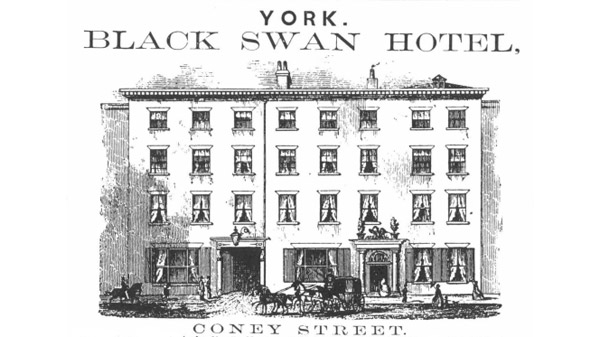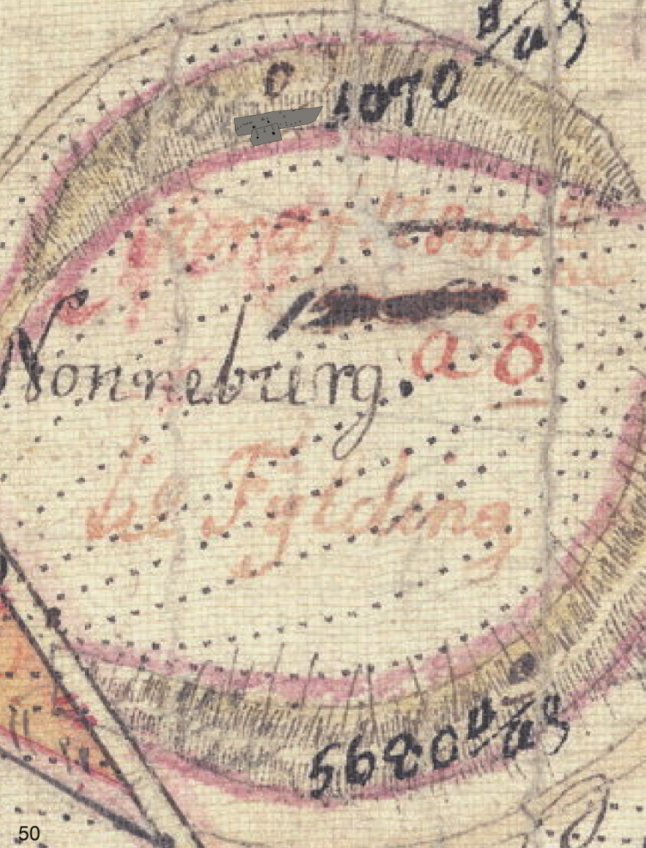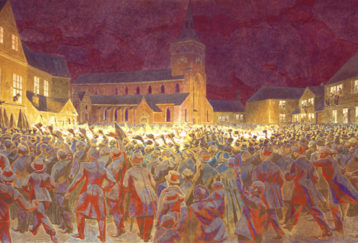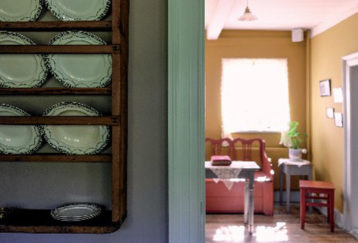
Paying the first of his two visits to England, in 1847, Andersen decided to go on to Scotland and chose, of course, to go by train, his favourite means of travel. The rail link between London and Edinburgh had not yet been completed; you had to get out at Newcastle, about three-quarters of the way along, and cross the River Tyne by omnibus. Wisely, therefore, our friend broke the journey at York, which is equidistant between the two capitals, 200 miles or about 320 kilometres in either direction. Andersen’s account of the overnight stay in Mit Livs Eventyr is tantalisingly brief:
»I “Black Swane” (sic) i York blev overnattet; jeg saae den gamle By med sin prægtige Kirke; saadanne maleriske Huse, med udskaaret Bjælkeværk i Gavle og Karnapper, som her, havde jeg endnu ikke seet. – Svalerne fløi i store Skarer omkring i Gaderne, og over mit Hoved min egen Fugl Storken«.
The Diaries are not much more informative:
»Da vi Kl 5 kom til York talte en Mand til mig, det var Willingtons (i. e. Wellingtons) ældste Søn, jeg kjendte ham ikke strax, løb fra ham, men vendte tilbage og undskyldte mig, præsenteredes for to Ladys; kørt til black Swane i York, efter Middagsbordet til Domkirken, der er prægtig, som snittet ud, i Smag som Köln vil blive. – Flere geistlige Bygninger, Jenny Linds Portræt. – Regnfuld Dag; vi mødte uendelig mange Tog, de susede som Raketter forbi, eet mødte vi i en Tunnel, her sidder Bjergpigen, Storkene flyve med og Svalerne. Et Par Ruiner. -«
One would have liked to hear more, and it would seem that, for once, Andersen failed to do his homework. York’s fascinating history would surely have appealed to him. As Eboracum, it had been the Roman military capital in northern Britain; two Roman emperors, Septimius Severus and Constantius Chlorus, died there, and Constantius’s son, Constantine, called the Great, was there proclaimed emperor by the legions. As Jorvik, it was the Viking capital of northern England and the names of many of its streets stil proclaim their Danish origins: Micklegate (Møgelgade), Stonegate (Stengade), Fishergate (Fiskergade), Swinegate (Svinegade eller Svenegade), Feasegate (Føhusgade), etc. It would have amused him to know that the Black Swan in Coney Street (Kongensgade) where he stayed was called by the locals, in broad Yorkshire dialect, t’Mucky Duck.

The Black Swan was an ancient coaching inn. Stage coaches ran three times a week from there to the Black Swan i Holborn, London, from 1703, performing the journey in four days, »if God permit«. The first through train service between York and London opened in 1840, only seven years before Andersen’s visit, and took 13 1/2 hours, soon reduced to ten. Today, the Inter-City train does it in a good two hours. With the introduction of the railway the Black Swan embarked on its downward course, though that may scarcely have been perceptible when Andersen stayed there, the last mail coach leaving in 1842. The inn gradually lost its custom as newer hotels were built, including the station hotel, to become famous in its turn as Royal Station Hotel. I vividly recall the Black Swan as its massive black beamed frontage gathered dust, in which I also remember inscribing my name or initials with my finger. The old inn, or what remained of it, closed finally in 1930 and was eventually demolished, the site occupied by a mock-Tudor building serving as a branch of the nationwide chain of Boots the Chemists. Such vandalism would not be allowed now; indeed the old inn would not only be preserved under conservation laws but would undoubtedly be a tourist attraction, perhaps bearing on its front a plaque proclaiming that Hans Christian Andersen stayed there on 10 August 1847.
Another detail in Andersen’s account of his stay in York has always intrigued me – the storks. Were there storks in York in those days? I was born and grew up in the city and have never seen one there, or indeed anywhere else in England, outside the Zoo. There were herons by the adjacent streams and rivers, as I remember from my bird-nesting days, now some 70 years ago, and herons bear a superficial resemblance to storks. But one would hardly expect Andersen to make the mistake of confusing the two. Seeking clarification, I wrote hopefully to the British Trust for Ornithology. This is the reply that I got:
»The White Stork Ciconia ciconia has been a rare straggler to Britain for as far back as reliable natural history records go (the 17th century). T H. Nelson in his two-volume work The Birds of Yorkshire (1907), knew of only 12 Yorkshire records for the species; these spanned 1798-1905, but none was in 1847.
That is as much as I am willing to say. There is no way one can evaluate Andersen’s claim in the absence of a detailed description of size, plumage, altitude of the flying bird, light conditions and visibility. A modern claimant of a sight record would be expected to provide such information to document his report«.
I also put in an inquiry in the Yorkshire Evening Press, York’s local newspaper, and a reader wrote quoting an article in the Natural History Journal and School Reporter for 1886:
»A stork – on the 10th of June, coming back from Scarborough, I saw a white stork. I had a good view, and called the attention of E. N. Mernell to it who also had a good view. We have both of us consulted books, illustrations, live and stuffed specimens and find they agreed with the bird we saw. It was large and certainly not a heron, and was fishing among some reeds in the mere just outside Scarborough. I believe it is a rarity in England«.
Some doubt remains of the credibility of Andersen’s account. He claims to have seen not one but more than one stork at York. If we allow him the benefit of the doubt and concede that what he saw were really storks and not herons, or some other birds, how are we to explain the remarkable coincidence that they should have made one of their notoriously rare appearances in England at the very time and in the very city where Andersen happened to be staying the night? Searching for a clue, one is driven to conclude that news of Andersen’s impending arrival had reached the ears of the stork community and that, flying in conclave, they had resolved to despatch some of their number to welcome their egen forfatter. Grossly unscholarly speculation, I fear. But – as somebody said – there are more things in heaven and earth, Horatio…


